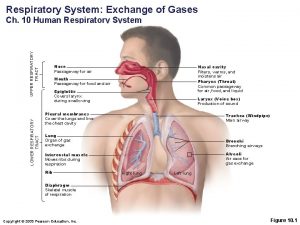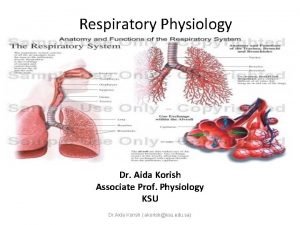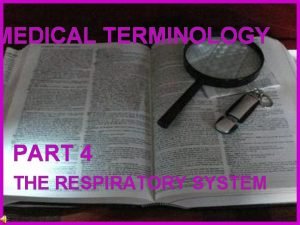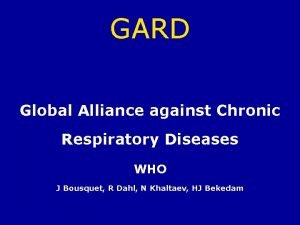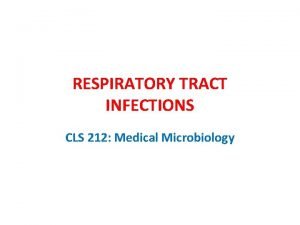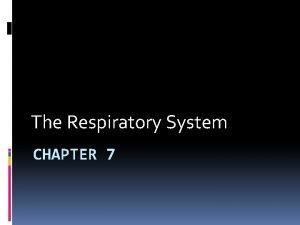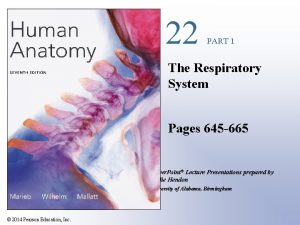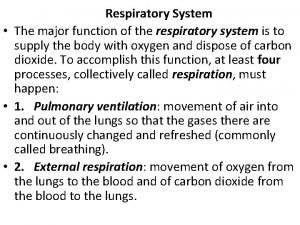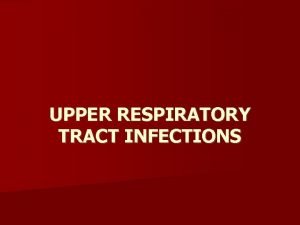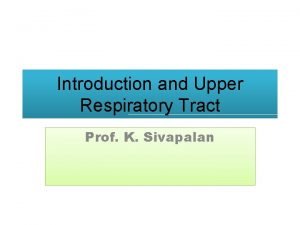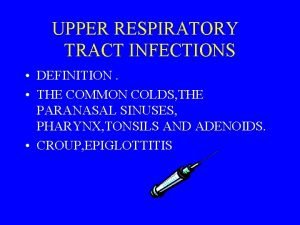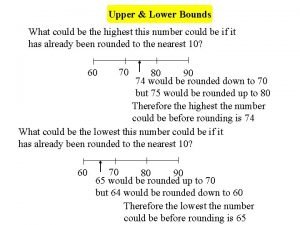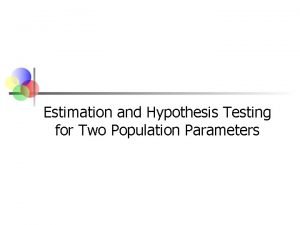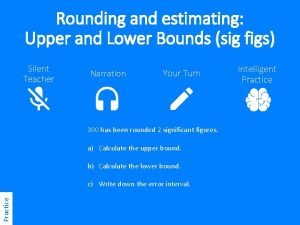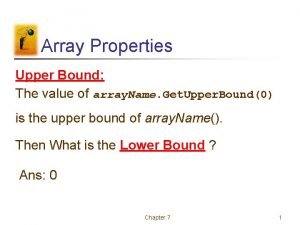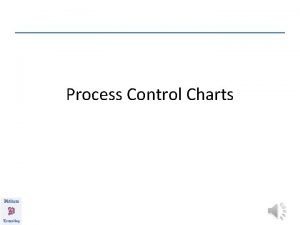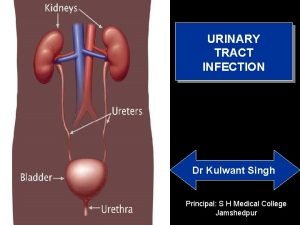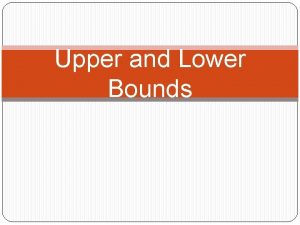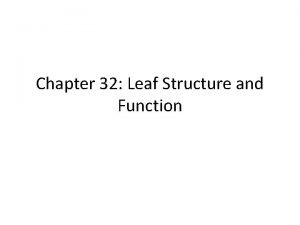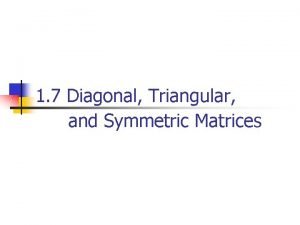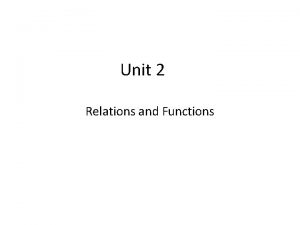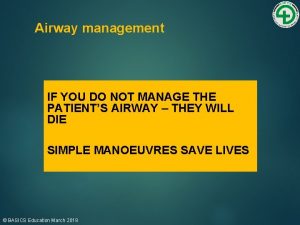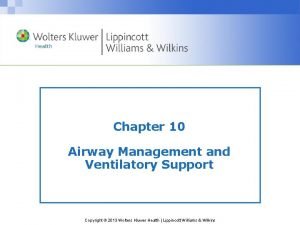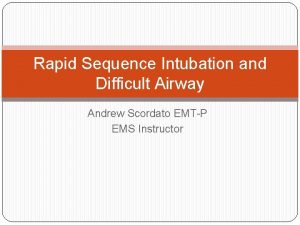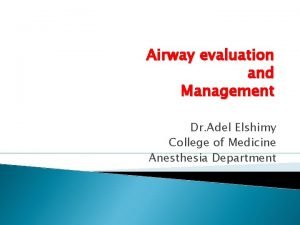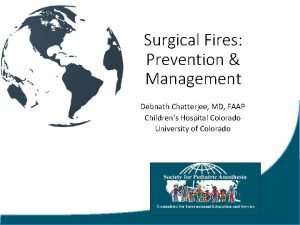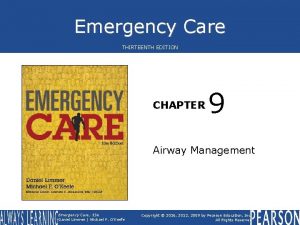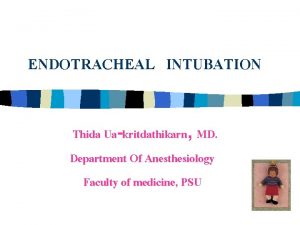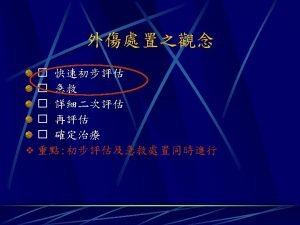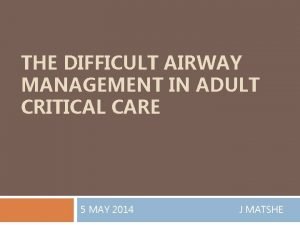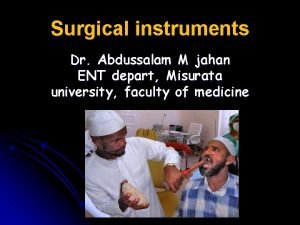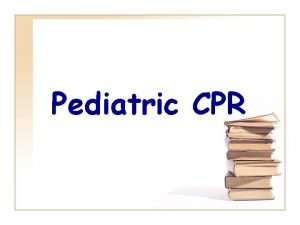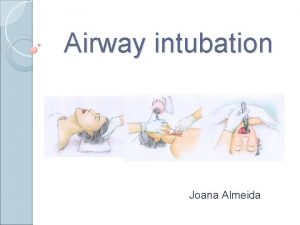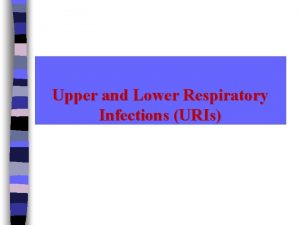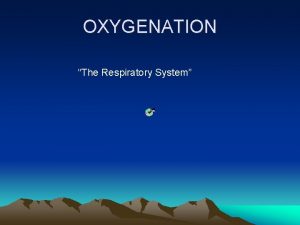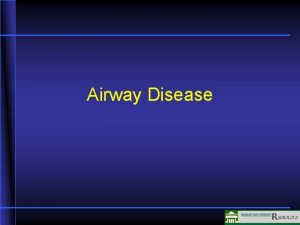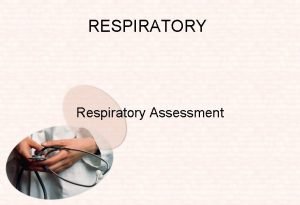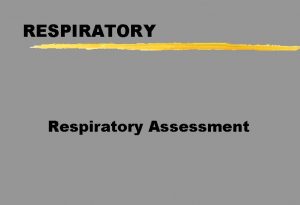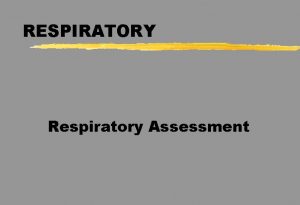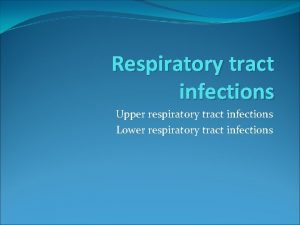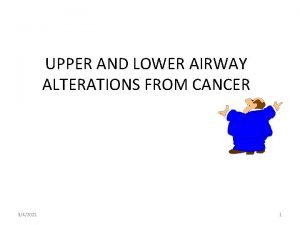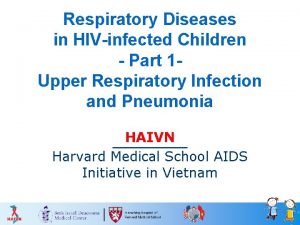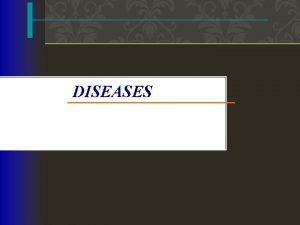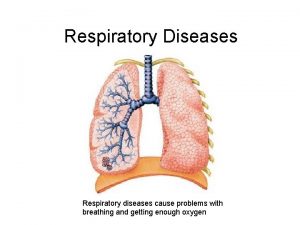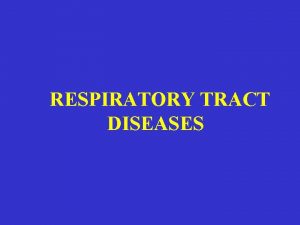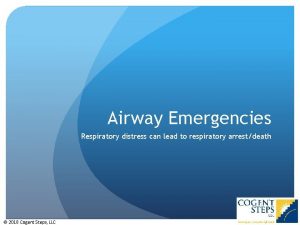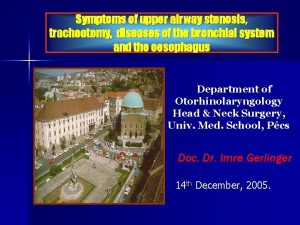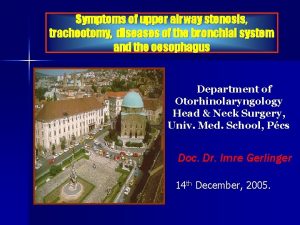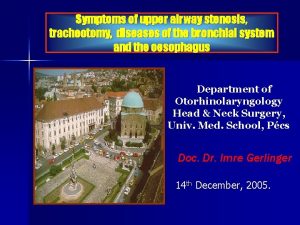Respiratory Diseases in Children Upper Lower Airway Diseases
























































- Slides: 56

Respiratory Diseases in Children 소아 호흡기 질환 소아청소년과 나영호

Upper & Lower Airway Diseases • Upper airway diseases – From nostrils to larynx – Inflammatory obstructive disease: croup – Bacterial tracheitis – Congenital laryngeal stridor • Lower airway diseases – From subglottis to terminal bronchiole – Bronchitis, Bronchiolitis, Pneumonia – Bronchial foreign body – Bronchiectasis, Pleurisy 2


기침의 분류: 기간에 따른 • • 급성: 4주 미만 만성: 4주 이상 지속성(Protracted): 2~4주 Prospective studies of acute cough following a viral infection – half : last less than 1 week – 70– 80% : for less than 2 weeks and – ≈ 5% : for more than 4 weeks • Healthy children: cough from 1 to 34 times every day 4



Pointers to specific cough Symptom/sign Auscultatory findings (wheeze, crepitations/crackles, differential breath sounds) Possible underlying etiology Asthma, , foreign body aspiration, any airway lesions (from secretions), airway abnormality, parenchymal disease such as interstitial disease Cough with choking primary aspiration, GERD Cough starting from birth Cardiac abnormalities Chest pain Chest wall deformity Digital clubbing Dyspnea Congenital abnormalities Any cardiac illness, associated airway abnormalities Arrhythmia, asthma, functional, pleuritis Any airway or parenchymal disease Suppurative lung disease, parenchymal disease Compromised lung function of any chronic lung or cardiac disease Failure to thrive Hemoptysis Immune deficiency Moist or productive cough Neurodevelopmental abnormality Recurrent pneumonia Any serious systemic including pulmonary illness Suppurative lung disease, vascular abnormalities Suppurative lung disease or atypical infection Suppurative lung disease Primary or secondary aspiration Immunodeficiency, suppurative lung disease, congenital lung abnormalities 7

Questions to address in cough evaluation (1) Questions Examples Diagnosis Very acute onset How did the cough start? Retained inhaled foreign body Head cold Infective cause (eg, postviral) When did the cough start? Neonatal onset (especially in first few days of life) Aspiration Congenital malformation Lung infection in utero Productive (‘moist or wet”) Chr suppuraive lung dis. (bronchiectasis) Paroxysmal spasmodic cough with/without an inspiratory ‘whoop’ and vomit Pertussis or pertussis like syndrome Hemoptysis Bronchiectasis, Retained FB, Tuberculosis, P. Hemosiderosis, AVM What is quality of cough? 8

Questions to address in cough evaluation (2) Questions What is quality of cough? Examples Diagnosis ‘‘Bizarre honking cough’’ in a child exhibiting ‘‘la belle indifference’’ to the cough and which increases with attention Psychogenic cough Dry repetitive cough, disappears with sleep Habit cough Brassy, barking or ‘‘seal-like’’ Tracheal or glottic cause (eg, tracheomalacia and/or bronchomalacia) Cough producing casts of the Plastic bronchitis airways Recommendations for the assessment and management of cough in children British Thoracic Society Cough Guideline Group Thorax 2008; 63(SIII): iii 1–iii 15. 9

Questions to address in cough evaluation (3) Questions Examples Is the cough an isolated symptom ? Diagnosis Isolated cough (otherwise well) Non-specific isolated cough Recurrent viral bronchitis Psychogenic cough Associated wheezing present Asthma, Retained inhaled foreign body Recurrent pulmonary aspiration Airways compression or tracheobroncho-malacia, Bronchiolitis obliterans or interstitial lung disease, Neonatal CLD Associated ill health, recurrent pneumonia or pulmonary infiltrates CF, Immune deficiencies, PCD Recurrent pulmonary aspiration, FB Tuberculosis, Persistent bacterial bronchitis, Anatomical disorder Associated shortness of breath and restrictive lung defect Interstitial lung disease 10

Questions to address in cough evaluation (4) Questions Examples Diagnosis Inhaled foreign body Lobar collapse Tuberculosis Rapidly expanding intrathoracic lesion Is the cough relentlessly progressive? Exercise, cold air, early morning What triggers the Lying down cough? Feeding Asthma Postnasal drip, gastrooesophageal reflux disease Recurrent pulmonary aspiration Recommendations for the assessment and management of cough in children British Thoracic Society Cough Guideline Group Thorax 2008; 63(SIII): iii 1–iii 15. 11











Bronchiolitis: Chest X-ray 22

Bronchiolitis: Chest X-ray 23

Bronchiolitis: Chest X-ray 24








폐렴(Pneumonia) 흉부 X-선상 침윤 • 해부학적 분류 – 대엽성(소엽성) 폐렴(lobar or lobular pneumonia) – 간질성 폐렴(interstitial pneumonia): reticular infiltration – 기관지 폐렴(bronchopneumonia, alveolar pneumonia): pachy infiltration 32

폐렴의 연령별 원인 신생아기 Group B streptococcus 그람 음성균(E. coli, Klebsiella) S. Aureus CMV, Chlamydia 영아기 RSV, PV, IV, Adenovirus, Enterovirus 바이러스는 영아기와 동일 유아기 S. pneumoniae, H. Influenzae Mycoplasma, H. Influenzae 학령기 Gr A. streptococcus Influenza A, B 33

Vesicular Sound: 정상 호흡음 34

Pnuemonia 35




Pneumococcal Pneumonia: LUL 39



Staphylococcal Pneumonia 42

Staphylococcal Pneumonia 43








Foreign body aspiration Inspiration Expiration 51



8 year-old girl with 4 -year history of daily wet and sometimes productive cough, which was worse on exertion. The CXR shows collapse and tram tracks of the right upper lobe and increased peribronchial and interstitial markings of the right lower lobe. HRCT: collapse and severe bronchiectasis of the right upper lobe. 54


Pleural Effusion 56
 Airway grade view
Airway grade view 5 functions of the respiratory system
5 functions of the respiratory system Upper and lower respiratory tract
Upper and lower respiratory tract Respiratory airway secretary
Respiratory airway secretary Norwich terrier upper airway syndrome
Norwich terrier upper airway syndrome Diseases of the respiratory system
Diseases of the respiratory system Global alliance against chronic respiratory diseases
Global alliance against chronic respiratory diseases Respiratory zone and conducting zone
Respiratory zone and conducting zone Pneumonia classification
Pneumonia classification Lower respiratory system
Lower respiratory system External nose
External nose What is the major function of the respiratory system
What is the major function of the respiratory system Upper rti
Upper rti Classification of upper respiratory tract infection
Classification of upper respiratory tract infection Broncheols
Broncheols Anatomy of the upper respiratory tract
Anatomy of the upper respiratory tract Ethmoditis
Ethmoditis Lower and upper extremes
Lower and upper extremes Upper lower bounds
Upper lower bounds Upper specification limit and lower specification limit
Upper specification limit and lower specification limit Combination roof plan
Combination roof plan How to find the critical f value
How to find the critical f value Lower bound 2 significant figures
Lower bound 2 significant figures Ye who enter here abandon all hope
Ye who enter here abandon all hope Limites de control
Limites de control What divided upper and lower egypt
What divided upper and lower egypt Upper egypt and lower egypt
Upper egypt and lower egypt Upper bound and lower bound in array
Upper bound and lower bound in array Upper and lower control limit formula
Upper and lower control limit formula Uti upper and lower
Uti upper and lower Programme upper lower
Programme upper lower Lower bound of 5
Lower bound of 5 Upper lower class
Upper lower class Mesophyll function
Mesophyll function Diagonal matrix multiplication
Diagonal matrix multiplication Chuck allison
Chuck allison Sig upper
Sig upper How to calculate upper and lower bounds
How to calculate upper and lower bounds Greatest lower bound and least upper bound
Greatest lower bound and least upper bound Nearest whole number upper and lower bounds
Nearest whole number upper and lower bounds Technique abcde
Technique abcde Airway ladder
Airway ladder Chapter 10 airway management
Chapter 10 airway management Airway breathing circulation disability exposure
Airway breathing circulation disability exposure Intubation anatomy
Intubation anatomy Sigh breaths on jet ventilator
Sigh breaths on jet ventilator Nasopharyngeal airway
Nasopharyngeal airway Fire risk assessment surgery
Fire risk assessment surgery Npa measurement
Npa measurement Airway numaraları
Airway numaraları What is this picture from
What is this picture from Nasopharyngeal airway
Nasopharyngeal airway Definitive airways
Definitive airways Lemon anaesthesia
Lemon anaesthesia Mouth gag airway
Mouth gag airway A airway b breathing c circulation
A airway b breathing c circulation Airway anatomy intubation
Airway anatomy intubation


